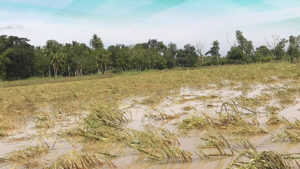DAMAGE to crops and aquaculture in flooded towns in the southern province of Maguindanao del Sur has reached over P50 million, according to the Bangsamoro agriculture ministry.
Rice, corn and vegetable farms spread across some 1,580 hectares in the towns of Datu Abdullah Sangki and Ampatuan were affected, with damage cost estimated at P39.31 million, the Bangsamoro region’s Ministry of Agriculture, Fisheries and Agrarian Reform reported following field validation on Oct. 31.
Fish farms stocked with tilapia, catfish and carp were damaged with losses pegged at over P9.38 million.
For livestock, damage was estimated at P1.69 million.
Other parts of Maguindanao province also recorded damage in banana and coconut plantations as well as farms with other high-value crops.
The ministry said damage validation in all areas were targeted for completion by Oct. 31, and assessment results will be used to “determine what urgent interventions must be carried out for the farmers, fisherfolk, and agrarian reform beneficiaries in the region.”
The Bangsamoro Autonomous Region in Muslim Mindanao, composed of five provinces in southern Philippines, has been experiencing rains over the past weeks and the rainfall volume was aggravated by tropical storm Nalgae, named Paeng locally, which struck a wide area of the country.
The biggest death toll from the storm was in the region with 59 people confirmed to have died and 16 still missing as of Nov. 1, based on the national disaster management council’s latest report.
Maguindanao Provincial Administrator Cyrus E. Torreña said state weather agency PAGASA provided sufficient rainfall and flood warnings and should not be accused of failing to issue timely forecasts.
President Ferdinand R. Marcos, Jr. on Saturday questioned why the flooding and landslides were not anticipated.
“Actually… we are not blaming PAGASA in this situation,” Mr. Torreña said in Filipino in an interview Monday evening with The Chiefs over One News.
“You know our weather patterns now, it can just suddenly change,” he said.
Mr. Torreña explained that it is most likely that saturated upland areas due to incessant rains could no longer absorb water, which triggered mudslides and flashfloods.
“And there was overflow in rivers,” he added. — MSJ

